Tortoises are land-dwelling reptiles that are often confused for their cousins, the turtle. The differences are that the tortoise tends to have a domed shell, lives exclusively on land, and has feet shaped like elephants’ instead of webbed feet. As slow-moving reptiles, these creatures are not capable of hunting down a meal. What do tortoises eat?
Discover the various foods that tortoises eat in the wild and in captivity! These interesting reptiles consume an array of foods.
What Foods Do Tortoises Eat?
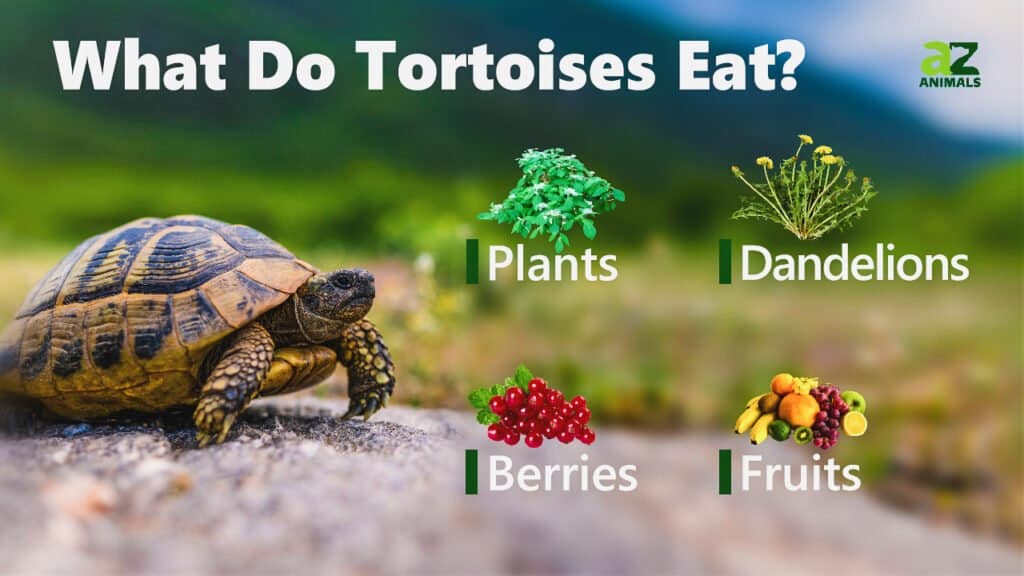
Tortoises eat leaves, grasses, fungi, and vegetables for most of their meals. Many species of tortoise are primarily herbivorous, but others are omnivorous. That means they will also consume some types of animal matter.
With that in mind, take a look at the most common foods that tortoises eat while living in the wild:
- Fungi
- Millipedes
- Clover
- Alfalfa grass
- Sowthistle grass
- Bermuda grass
- Mulberry leaves
- Hibiscus leaves
- Aloe
- Barley
- Hay
- Grains
- Earthworms
- Snails
- Slugs
- Carrion
- Mushrooms
- Melons
- Apples
- Pears.
These are some of the typical foods that a tortoise can find in the wild. The range of the tortoise is large and stretches across the world, including some of North America, South America, Asia, parts of Africa, and more. Thus, they have access to a lot of different meals around the globe.
Most interestingly, their diet can include actual meat from dead animals (carrion) as well as a variety of insects. They are opportunistic when eating insects and meat; they do not hunt for these foods. Tortoises greatly prefer plants, fruits, and vegetables to any other foods.
How Do Tortoises Forage and Find Food?
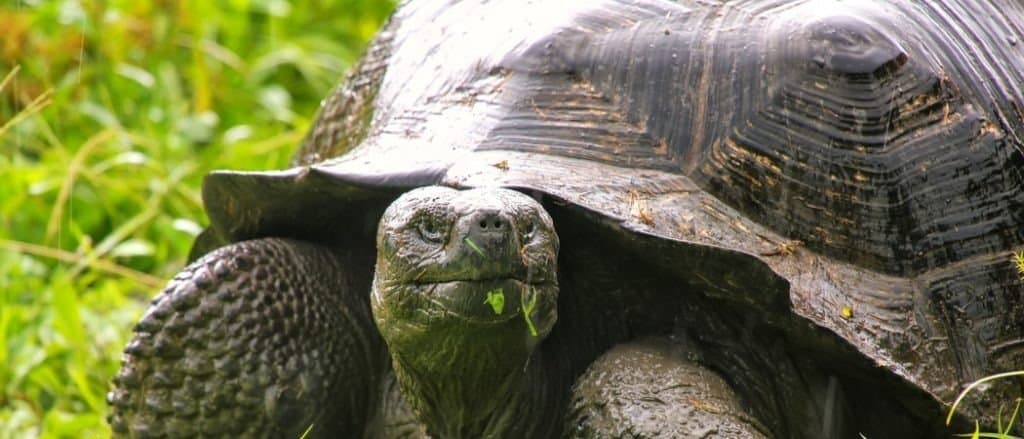
Tortoises have a great sense of smell that helps them find food.
©Don Mammoser/Shutterstock.com
Tortoises primarily use their sense of smell to find food that they want to eat from afar. However, they have good sight that allows them to see in twilight and dark conditions, so they can also spot food at the end of the day and nighttime.
Tortoises are diurnal reptiles, so they tend to be more active in the day compared with the night but they also are active in the twilight hours. Their unique sight helps find food in these conditions.
As slow-moving reptiles, tortoises have to spend a large portion of their day foraging for food. Most of these species can only move at less than 1mph, so getting to a food source takes a serious amount of time. Fortunately, the food they eat does not often change locations once it has been spotted.
These reptiles tend to find food that is close to their burrow, often less than a few hundred feet away. Aside from searching for food, they might leave their burrows to migrate, flee from danger, or seek breeding opportunities. They will also make new burrows to suit their needs.
What Do Pet Tortoises Eat?
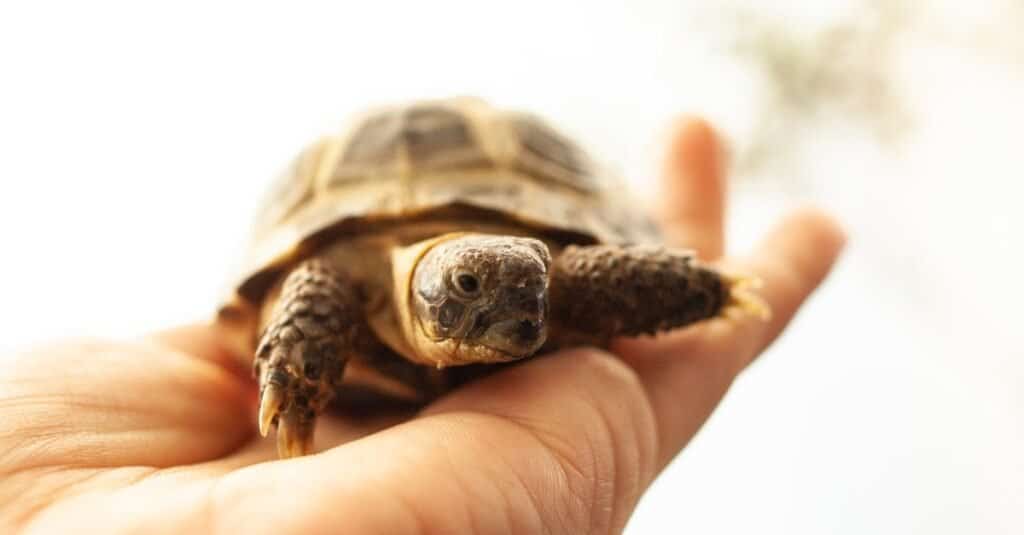
Pet tortoises eat plants, vegetables, and commercial foods.
©KOTORICHIKAPHOTO/Shutterstock.com
Tortoises are popular pets for people who do not want to deal with an aquatic environment in their homes. However, it is not always possible to precisely mimic the food offerings that they would get in the wild. Nevertheless, pet owners have identified several foods that provide great nutrition for their tortoise pets.
Pet tortoises eat:
- Kale
- Collard greens
- Clover
- Earthworms
- Mulberry leaves
- Sweet potato
- Artichoke
- Dandelions
- Bell peppers
- Squash
- Mango
- Peach
- Grapes
- Strawberries
- Commercial tortoise foods.
Each of these foods is a good option for a tortoise. You must keep in mind that the majority of their food in the wild and as pets comes from leafy green vegetables. However, if a pet owner is struggling to obtain these foods, then they can always go to a pet shop that specializes in reptile care and obtain commercial foods.
These commercial food mixes will provide the tortoise with all the nutrition needed to stay healthy, and they can be supplemented with fruits and even a few animal products to provide a full, well-rounded diet. Of course, not every tortoise eats or desires live food.
What Can Tortoises Not Eat?
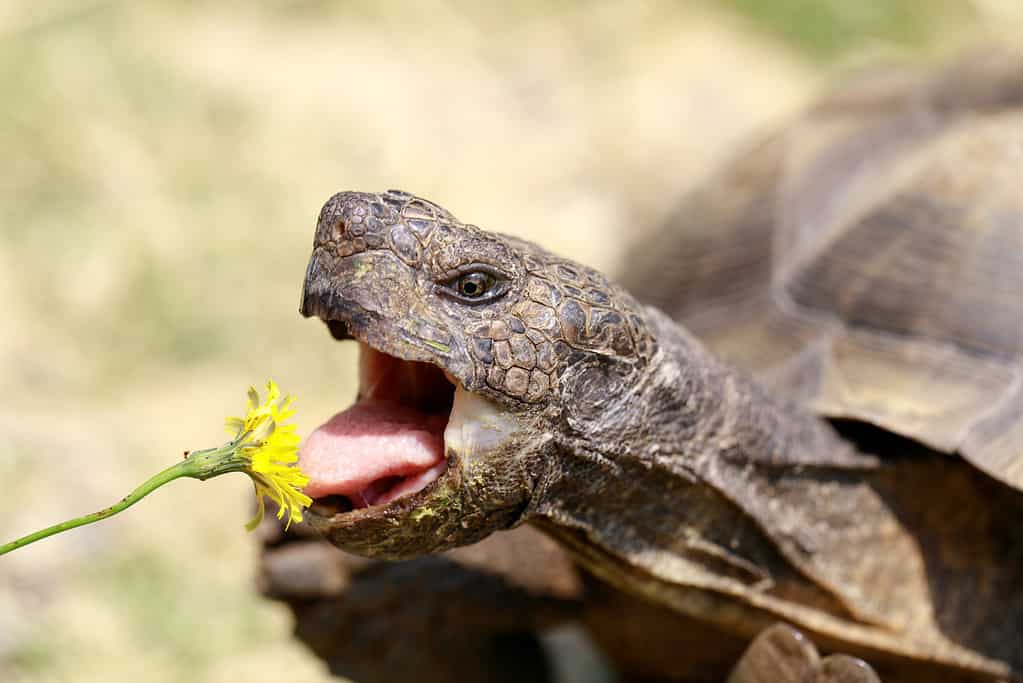
Tortoises should not be fed items that have high levels of oxalic acid which blocks the absorption of calcium.
©yhelfman/ via Getty Images
There are a wide variety of foods that both wild and pet tortoises can, and do eat. However, there are also certain foods that they should never consume. As wild animals, they aren’t likely to come across these foods but when kept as pets, there may be a higher chance if owners are unaware of forbidden foods.
Tortoises should not be fed the following items due to their high levels of oxalic acid, which blocks the absorption of calcium and can be harmful to them:
- Broccoli
- Cauliflower
- Spinach
While you may be able to let them have small amounts of spinach, it is best to avoid it entirely in order to avoid potential issues.
How Much Do Tortoises Eat?

Tortoises eat a food plate as large as their shells once a day.
©Jenny Sturm/Shutterstock.com
Despite the size of the largest tortoises which can exceed 3 feet in length and weigh hundreds of pounds, most species of tortoise are quite small, maxing out at a length of 8-12 inches and weighing fewer than 10 pounds.
When they are in the wild, tortoises forage for food throughout the day, so it can be difficult to track how much they eat. As pets, it is a bit easier to get an idea of how much they eat. Pet tortoises eat 5 days a week, with two “starve” days built into their diet to help their digestive system catch up to the amount of food they consume.
Typically, pet tortoises are fed a mixture of leafy greens, vegetables, and fruit in a meal set that is about as large as their shell. At least 80% of this is leafy greens and other vegetables and the rest can be fruit, and commercial foods or protein sources to round out the diet.
Tortoises are fed one large meal on feeding days. Tortoises can eat about 5% of their body weight in a meal, depending on size.
What Predators Eat Tortoises?
These slow-moving reptiles only have a few defensive methods against predators. They can retract their limbs and head into their shell or hide in their burrows. They can defensively use their beaks, but that comes at the cost of protecting their heads in their shells.
Although their shell can ward off some predators, it’s not enough to save them in all cases.
Take a look at some of the most common predators that can eat tortoises:
These are just a few of the general predators that kill tortoises, especially eggs and younglings. Humans may also count as a predator since they destroy tortoise habitats.
Tortoises are land-dwelling reptiles that consume various vegetables, plants, fruits, and even invertebrates. Although they are slow and somewhat fragile, they can use their smell and sight to find food while foraging.
They spend most of their day in pursuit of food, but they eat relatively little. They are great pets, and they have a very long lifespan, with some species outliving humans!
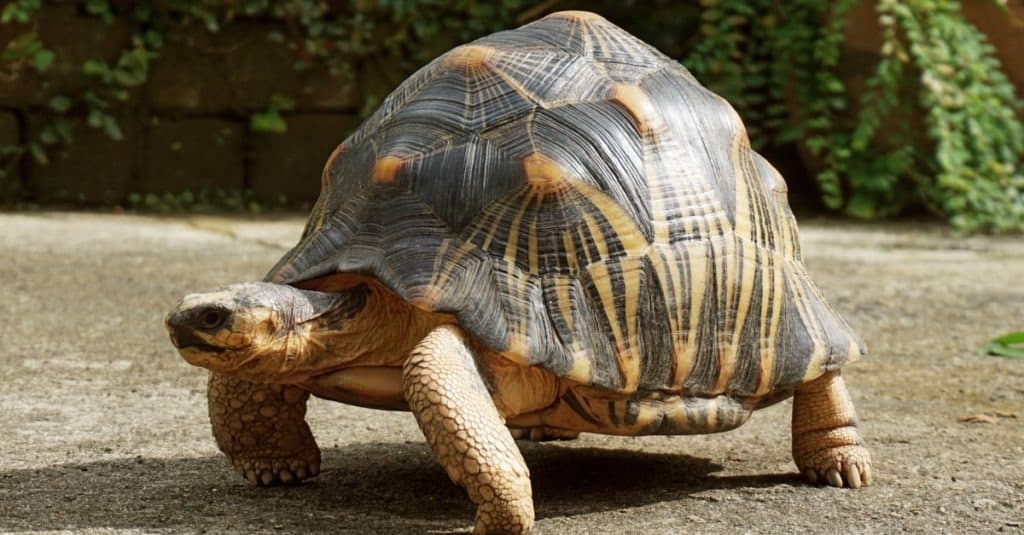
A tortoise’s shell is its best defense against predators in the wild.
©seasoning_17/Shutterstock.com
How Long Do Tortoises Live?
When you adopt a pet tortoise it is important to know that your pet will probably outlive you! Tortoises are well known for having some of the longest lifespans of any animal, with most living 100-150 years. Some link the tortoise’s incredible longevity to their extremely slow metabolisms, with Galapagos Tortoises having an average resting heart rate of 25 beats per minute.
The oldest tortoise ever recorded is actually still alive today. Born in 1832, Jonathan the Seychelles giant tortoise is over 190 years old today. He resides in the British overseas territory of Saint Helena where local residents celebrate his birthday every year. He has been partnered with another tortoise named Frederika since 1991. Jonathan is blind and has lost his sense of smell, but is well cared for and in remarkable health for his almost 2-century-old age.

Here we see Jonathan at his comfortable home in Saint Helena, looking great for 190!
©iStock.com/StHelena
Where Do Tortoises Live?
Tortoises are exclusively land-dwelling reptiles, unlike their water-loving cousins the turtle. They can be found on five out of seven continents, all but Australia and Antarctica, as well as many islands. Different species of tortoises have adapted traits to survive in a plethora of environments, from harsh, arid deserts to tropical forests that blossom with life.
Temperature is one of the most vital factors in the habitability of a region for a tortoise due to the fact that they are cold-blooded, and rely on the temperature of the environment around them to regulate their own body heat. This means you will often find tortoises basking in the sun or soaking up the shade depending on the time of day. Tortoises are also fond of grasslands, as much of their diet consists of plant protein found in abundance within the grassy plains.

Strawberries are one of the tortoises’ favorite snacks.
©Elena M. Tarasova/Shutterstock.com
Summary of What Tortoises Eat
Here’s a recap of what foods tortoises in the wild commonly consume:
| Number | Food |
|---|---|
| 1 | Fungi |
| 2 | Millipedes |
| 3 | Clover |
| 4 | Alfalfa grass |
| 5 | Sowthistle grass |
| 6 | Bermuda grass |
| 7 | Mulberry leaves |
| 8 | Hibiscus leaves |
| 9 | Aloe |
| 10 | Barley |
| 11 | Hay |
| 12 | Grains |
| 13 | Earthworms |
| 14 | Snails |
| 15 | Slugs |
| 16 | Carrion |
| 17 | Mushrooms |
| 18 | Melons |
| 19 | Apples |
| 20 | Pears |
Pet tortoises can be fed a range of foods, including:
| Number | Food |
|---|---|
| 1 | Kale |
| 2 | Collard greens |
| 3 | Clover |
| 4 | Earthworms |
| 5 | Mulberry leaves |
| 6 | Sweet potato |
| 7 | Artichoke |
| 8 | Dandelions |
| 9 | Bell peppers |
| 10 | Squash |
| 11 | Mango |
| 12 | Peach |
| 13 | Grapes |
| 14 | Strawberries |
| 15 | Commercial tortoise foods |
The photo featured at the top of this post is © iStock.com/GoDogPhoto
Thank you for reading! Have some feedback for us? Contact the AZ Animals editorial team.






